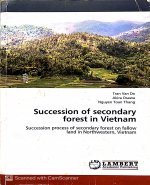Succession of secondary forest in Vietnam

Shifting cultivation has been criticized as main cause of tropical deforestation and carbon emission, however it is still the main type of agriculture in many parts of the world, especially in developing countries. Succession studies indicated that recovery of forest has been affected by several factors such as forest types, disturbance regimes, geographical location. We had become interested in studying recovery of forest following pioneer shifting cultivation, which has been practiced by H’Mong people in Northwestern, Vietnam. By this type of shifting cultivation, H’Mong people clearcut, burn natural forest and cultivate for several years until the soil become degraded and crops can not grow anymore before abandoning the land. Even highly disturbed as reduce of soil fertility, nearly complete remove of soil seed bank as seeds, stumps and roots, the land till can recover to return to old-growth forest both in term of aboveground biomass and species diversity. By observing dynamics of early successional species, we found that they played an importance role in the first ten years after land abandonment as catalysts for recruitments of the late successional species, then recovery process can be shortened by shortening importance role of early successional species through increase their seed rain to the abandoned field in the first several years after land abandonment. Recovery of commercially valuable species was quite slow in the first 32 years of land abandonment, if purpose of current forest is to produce timber then supplementing stems of those species may be required through seeding and/or adding seedlings at specific time of stand development.
THE SAME CATEGORIES